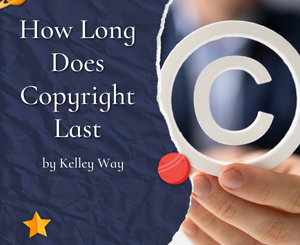Copyright and Reverse-Engineering by Kelley Way
 Let’s welcome back monthly columnist Kelley Way as she shares with us “Copyright and Reverse-Engineering.” Enjoy!
Let’s welcome back monthly columnist Kelley Way as she shares with us “Copyright and Reverse-Engineering.” Enjoy!
***
My sister inspired this blog article when she noticed a trend in the knitting world.
She saw several social media posts where knitters saw a design they liked, reverse-engineered it, and then gave away the pattern or offered it for sale.
She asked me about the legality of this practice, and it reminded me of stories I heard from marketing teams, where they would copy pictures or artwork off the Internet. Then, if someone pointed out this was problematic, they would recreate the design themselves and declare it non-infringing.
Unfortunately, this is not how copyright works
Copyright law protects a work from being copied without permission; the fact that the picture or design is on the Internet does not mean it is free for anyone to use.
Copyright also protects against the creation of derivative works, which are works that are based on the original.
Even if you change some details– or a lot of details– drawing a recreation of an existing work qualifies as a derivative work and therefore infringes on the original’s copyright.
The same holds true if you simply modify or crop an existing picture.
Does this mean you can’t use an existing work?
Not necessarily. Here are some times when you might be okay:
The work is not copyrighted
If it doesn’t have a copyright, then your use is not infringing.
Older works (pre-1927) and certain government works (e.g. Hubble telescope photos) are not protected by copyright and can be freely used.
You have permission
While it can be challenging to reach out and ask for permission, many sites let you use or modify photos and art with a blanket subscription or, in some cases, for free — just make sure the site got permission from the author first.
Search browsers also have filters that will only show photos that have been licensed for reuse.
Fair use applies
This one is the trickiest and the most risky.
Certain uses — e.g. education, news reporting or commentary– are presumably fair use, but that’s not a guarantee that your specific use is okay.
A good rule of thumb is asking — Will this hurt the original’s sales?
While this is not the only factor the courts will consider, it is an important one and will also impact the likelihood of the copyright owner coming after you.
Another option is to change it so drastically that it’s not really comparable to the original, but this move is a lot riskier and the lower courts are less likely to rule in your favor.
Don’t Take Risks
When in doubt, it’s best to either get permission — in writing — or have a lawyer run a risk analysis for you.
It’s not worth the potential lawsuit to just assume that you’ll be okay.
If you have questions, want to know, “Can I reverse-engineer this design?”, or if you just want to know if your use is okay, don’t hesitate to contact me at kaway@kawaylaw.com.
***
Want to read more articles like this one Writer’s Fun Zone? Subscribe here.
***
ABOUT THE AUTHOR
Kelley Way was born and raised in Walnut Creek, California. She graduated from UC Davis with a B.A. in English, followed by a Juris Doctorate. Kelley is a member of the California Bar, and an aspiring writer of young adult fantasy novels. More information at kawaylaw.com.
Also by Kelley Way
https://writersfunzone.com/blog/2022/06/07/when-should-i-copyright-my-work-by-kelley-way
https://writersfunzone.com/blog/2022/05/10/3-reasons-to-register-your-copyright-by-kelley-way







